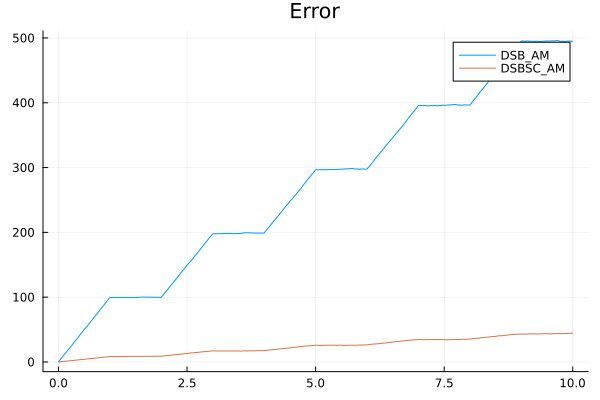Comparison of DSB AM and DSBSC AM modulation in a channel with limited white noise
This model demonstrates differences in transmission stability and efficiency between two-band carrier amplitude modulation (DSB AM) and suppressed carrier modulation (DSBSC AM) in band-limited white noise communication channels. It consists of a signal generator, modulation and demodulation channels, as well as blocks for calculating and analyzing errors.
The model itself is shown in the picture below.

The main blocks of the model are described below.
The initial signal generation consists of two blocks.
- Sine Wave: Generates the original harmonic signal.
- Zero-Order Hold: Provides sampling by fixing the signal level at each time step.
The first branch is DSB AM.
- DSB AM Modulator Passband modulates the signal while maintaining the carrier frequency, which simplifies transmission and demodulation.
- Adding noise: Band-Limited White Noise is added to the signal using the Add block, which allows you to simulate a real noise communication channel.
- DSB AM Demodulator Passband demodulates the signal, restoring the original information.
- Error comparison and calculation.
- Add finds the difference between the source signal and the output signal of the demodulator.
- Abs calculates the absolute error value for each sample.
- Average Filter — a filter with a sliding window of 1000 samples for calculating the average error.
The second branch, DSBSC AM, differs only in modulation units.
- DSBSC AM Modulator Passband modulates the carrier-suppressed signal. Energy is concentrated on the side lanes, which reduces energy costs.
- DSBSC AM Demodulator Passband demodulates the signal, requiring precise synchronization to restore the carrier frequency, since the carrier is not transmitted.
Let's move on to modeling
Declaring an auxiliary function
# Enabling the auxiliary model launch function.
function run_model(name_model)
Path = (@__DIR__) * "/" * name_model * ".engee"
if name_model in [m.name for m in engee.get_all_models()] # Checking the condition for loading a model into the kernel
model = engee.open( name_model ) # Open the model
model_output = engee.run( model, verbose=true ); # Launch the model
else
model = engee.load( Path, force=true ) # Upload a model
model_output = engee.run( model, verbose=true ); # Launch the model
engee.close( name_model, force=true ); # Close the model
end
sleep(5)
return model_output
end
Initializing and launching the model
Noise_power = 0.1;
window = 1000;
run_model("DSB_and_DSBSC") # Launching the model.
Average_error_DSB = collect(Average_error_DSB);
Average_error_DSBSC = collect(Average_error_DSBSC);
Result analysis
gr()
plot(Average_error_DSB.time,Average_error_DSB.value, title = "Error", label = "DSB_AM")
plot!(Average_error_DSBSC.time,Average_error_DSBSC.value, title = "Error", label = "DSBSC_AM")
As we can see on the graph, the average error value is lower in the case of DSBSC AM. This is due to the differences between these two types of modulation. Let's take a closer look at them.
DSB AM (with carrier).
- Modulation characteristic: The signal is transmitted from the carrier, which simplifies demodulation, since the carrier frequency can be easily recovered by the receiver.
- Energy consumption: requires more power, as part of the energy goes to the carrier.
- Noise resistance: more susceptible to noise, as the carrier is also susceptible to distortion.
- Advantages: Easy demodulation, which makes it convenient for systems with limited computing power or simplified synchronization.
- Disadvantages: low energy efficiency, since a significant part of the power is spent on carrier transmission.
DSBSC AM (with suppressed carrier).
- Modulation characteristic: transmission occurs only due to sidebands, making the circuit more energy efficient.
- Energy consumption: requires less power, since the carrier is not transmitted, and energy is concentrated on useful information.
- Noise resistance: Less prone to noise compared to DSB AM, but requires precise timing for demodulation.
- Advantages: high energy efficiency and better noise immunity compared to DSB AM.
- Disadvantages: difficulty in demodulation due to the need for precise synchronization with the reference frequency.
Conclusion
The main result of the demonstration: we saw that the average error value for DSBSC AM is lower than for DSB AM.
This difference is explained by the peculiarities of the modulation methods themselves: in DSBSC AM, the signal power is concentrated only in the side bands, which makes it less sensitive to noise compared to DSB AM, where part of the energy is spent on carrier transmission. In DSB AM, this additional carrier is subject to distortion and introduces additional error when restoring the signal after passing through the noise channel.
Thus, this comparison confirms that DSBSC AM has higher noise resistance and higher energy efficiency, which makes it preferable in systems requiring a high level of interference protection and minimal energy consumption.
